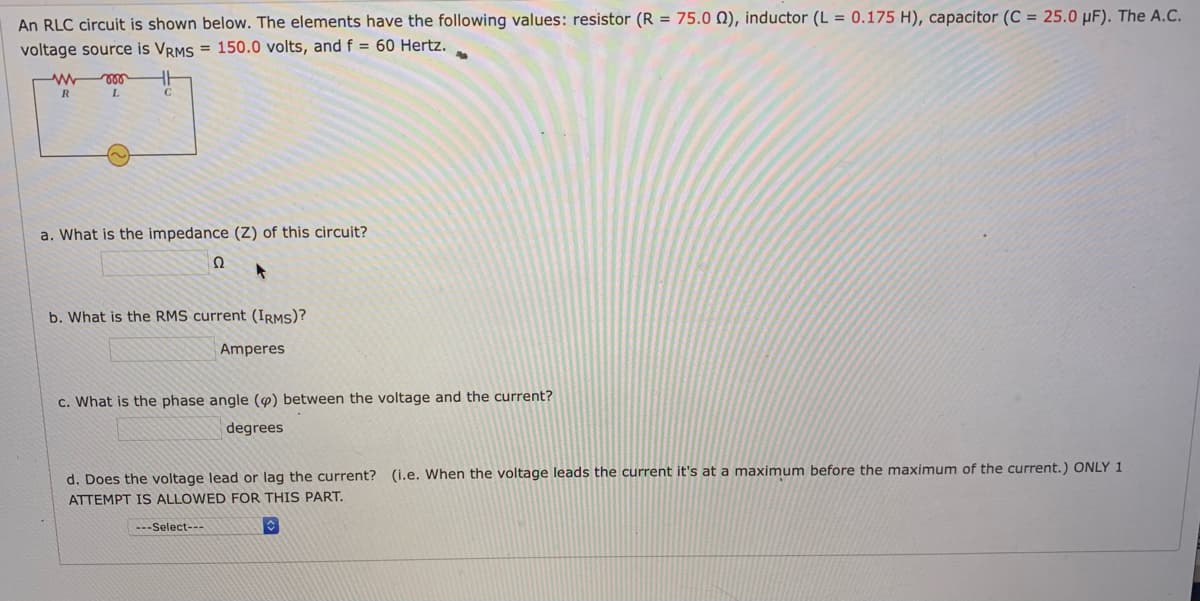An RLC circuit is shown below. The elements have the following values: resistor (R = 75.0 N), inductor (L = 0.175 H), capacitor (C = 25.0 µF). The A.C. voltage source is VRMS = 150.0 volts, and f = 60 Hertz. a. What is the impedance (Z) of this circuit? Ω b. What is the RMS current (IRMS)? Amperes c. What is the phase angle () between the voltage and the current? degrees d. Does the voltage lead or lag the current? (i.e. When the voltage leads the current it's at a maximum before the maximum of the current.) ONLY 1 ATTEMPT IS ALLOWED FOR THIS PART.
An RLC circuit is shown below. The elements have the following values: resistor (R = 75.0 N), inductor (L = 0.175 H), capacitor (C = 25.0 µF). The A.C. voltage source is VRMS = 150.0 volts, and f = 60 Hertz. a. What is the impedance (Z) of this circuit? Ω b. What is the RMS current (IRMS)? Amperes c. What is the phase angle () between the voltage and the current? degrees d. Does the voltage lead or lag the current? (i.e. When the voltage leads the current it's at a maximum before the maximum of the current.) ONLY 1 ATTEMPT IS ALLOWED FOR THIS PART.
College Physics
1st Edition
ISBN:9781938168000
Author:Paul Peter Urone, Roger Hinrichs
Publisher:Paul Peter Urone, Roger Hinrichs
Chapter23: Electromagnetic Induction, Ac Circuits, And Electrical Technologies
Section: Chapter Questions
Problem 102PE: An RLC series circuit hag a 1.00 k(register, a 150 (H inductor, and a 25.0 nF capacitor. (a) Find...
Related questions
Question
100%

Transcribed Image Text:An RLC circuit is shown below. The elements have the following values: resistor (R = 75.0 N), inductor (L = 0.175 H), capacitor (C = 25.0 µF). The A.C.
voltage source is VRMS = 150.0 volts, and f = 60 Hertz.
C
a. What is the impedance (Z) of this circuit?
Ω
b. What is the RMS current (IRMS)?
Amperes
c. What is the phase angle (@) between the voltage and the current?
degrees
d. Does the voltage lead or lag the current? (i.e. When the voltage leads the current it's at a maximum before the maximum of the current.) ONLY 1
ATTEMPT IS ALLOWED FOR THIS PART.
---Select---
Expert Solution
This question has been solved!
Explore an expertly crafted, step-by-step solution for a thorough understanding of key concepts.
This is a popular solution!
Trending now
This is a popular solution!
Step by step
Solved in 3 steps

Knowledge Booster
Learn more about
Need a deep-dive on the concept behind this application? Look no further. Learn more about this topic, physics and related others by exploring similar questions and additional content below.Recommended textbooks for you

College Physics
Physics
ISBN:
9781938168000
Author:
Paul Peter Urone, Roger Hinrichs
Publisher:
OpenStax College

Physics for Scientists and Engineers: Foundations…
Physics
ISBN:
9781133939146
Author:
Katz, Debora M.
Publisher:
Cengage Learning

Physics for Scientists and Engineers
Physics
ISBN:
9781337553278
Author:
Raymond A. Serway, John W. Jewett
Publisher:
Cengage Learning

College Physics
Physics
ISBN:
9781938168000
Author:
Paul Peter Urone, Roger Hinrichs
Publisher:
OpenStax College

Physics for Scientists and Engineers: Foundations…
Physics
ISBN:
9781133939146
Author:
Katz, Debora M.
Publisher:
Cengage Learning

Physics for Scientists and Engineers
Physics
ISBN:
9781337553278
Author:
Raymond A. Serway, John W. Jewett
Publisher:
Cengage Learning

Physics for Scientists and Engineers with Modern …
Physics
ISBN:
9781337553292
Author:
Raymond A. Serway, John W. Jewett
Publisher:
Cengage Learning


College Physics
Physics
ISBN:
9781305952300
Author:
Raymond A. Serway, Chris Vuille
Publisher:
Cengage Learning